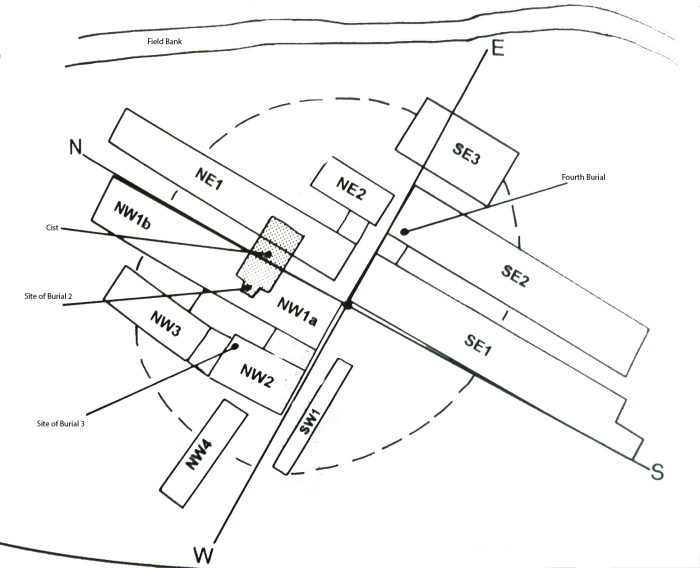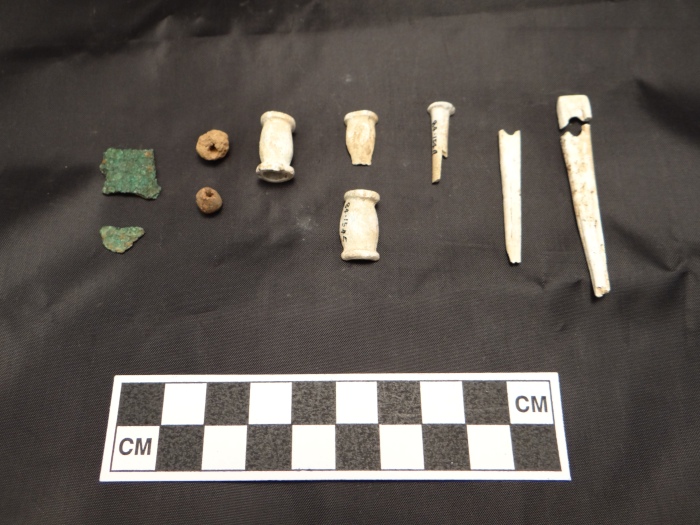Author: Rachel
This week our blog returns after its Christmas break. Just before Christmas Chris gave a short lecture about the Staarvey pommel at the Theoretical Archaeology Group conference in Southampton. His paper had a large audience and it gave us a chance to raise awareness of the project and tell people about the island’s excellent prehistoric archaeology. Next week we are going to be on island for a few days looking at some finds and doing some research in the archive. We will also be doing an interview with Manx Radio which we will post the details for when it is released!
This week the blog is going to focus on a site not far from Staarvey which has some similar finds: The Cronk, Upper Lherghydhoo.
The Cronk, Upper Lherghydhoo was excavated by Sheila Cregeen, a Manx archaeologist, and Prof. Etienne Rynne, an archaeologist from Ireland, between 1980-81. Dr. Jenny Woodcock brought together both Sheila Cregeen and Etienne Rynne’s notes on the excavations and published a paper summarising their findings in the Proceedings of the Isle of Man Natural History and Antiquarian Society journal in 1996 (accessible in the Manx Museum Library). The site itself lies in the hills that rise up to the northeast of Peel and is barely visible today as the mound was thoroughly excavated and the field it is in is now under pasture.
As is often the case, this site first came to light when the farmer, Mr Ian Parker, was ploughing one of his fields and kept noticing fragments of sandstone in the plough. This was particularly intriguing as his field was some distance from the sandstone outcrops in Peel. He contacted Shiela Cregeen in May 1980 and together they discovered a cist in his field. The cist was constructed of red Peel sandstone and aligned roughly east-west. The sandstone for the cist must have been brought to the area from Peel specifically for this burial. The cist contained an inverted Food Vessel Urn as well as cremated remains. Accompanying the remains within the cist were two bone bodkins, a bone pin, and two bone beads. Some of the cremated remains from this site were radiocarbon dated in the 2000s and produced a radiocarbon date of 1882-1641 calBC (GrA-29936).

Sheila Cregeen returned to the site in August 1980 to try and enhance her understanding of the site and the cist. Her aim was to look at the pit that the cist had been placed within and to try and understand whether the cist was the primary burial at the centre of the original mound. Archaeological excavations can be a bit unpredictable – instead of answering her questions about the cist she discovered a secondary burial, next to the cist. She found a small pit holding an upright undecorated Urn containing cremated remains, some fragments of charcoal, two clay beads, and an unworked flint chip.

In October 1981, Prof. Etienne Rynne directed an excavation to try and finally establish how many burials were within the mound and within what order they might have occurred. He opened multiple excavation trenches across the area and discovered another two burials (!) as well as establishing the original area of the mound. The third burial consisted of a Cordoned Urn and some cremated remains. The Urn had not survived well and had been disturbed and scattered across a small area. In addition to the cremated remains there was also a leaf-shaped flint blade and a burnt plano-convex flint knife – the flint knife may well have been burnt on the pyre with the body(ies) of the deceased. The Urn was placed on top of a cup-marked slate slab. Cup-marks are a form of rock art consisting of small hollows that are carved into the rock (there are lots to be found on the Meayll peninsular between The Sound and Cregneash). We quite often find cup-marked rocks in association with Early Bronze Age burials.

Prof. Rynne discovered a further concentration of cremated remains in the eastern part of the mound as well as two small fragments of bronze. This was almost certainly a fourth burial, accompanied by a bronze blade, which had been disturbed (probably by ploughing).

Prior to Michelle’s new finds from Staarvey the bone finds from The Cronk, Upper Lherghydhoo were some of the only bone objects we knew about from the Early Bronze Age on the Isle of Man (the others are a bone needle and some beads that eroded from a cliff on the north of the island). The two sites are near to each other and have relatively similar radiocarbon dates. There are other similarities in burial practice between the two sites such as the use of an inverted pottery vessel, in a cist and the inclusion of bone object. On our visit to the museum next week we will be carefully examining all the bone objects from both sites to see what more we can learn.
Hi, I have found this blog very interesting. When are you planning to have any events that people can come and see the sites and finds?
LikeLike
Hi There! We are Glad to hear you have been enjoying the blog. We are working on our plans for this year at the moment, so hopefully we will have some news for you fairly soon! Cheers, Rachel
LikeLike